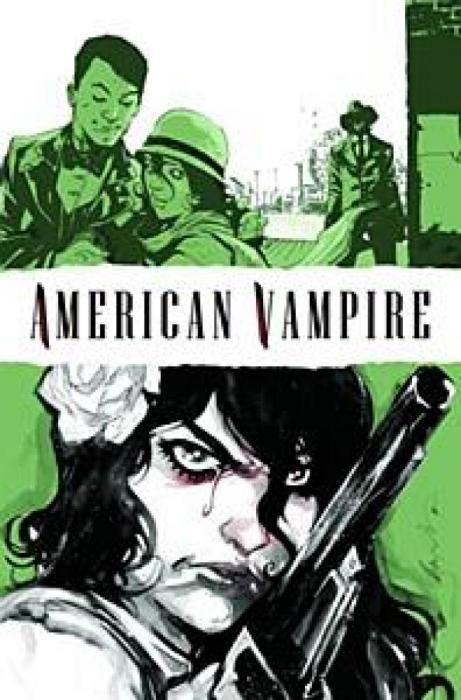If you need to know one thing about "American Vampire," it's this: this is not a typical vampire story. Sure, it's got all of the necessary elements of a classic vampire story -- forsaken love, betrayal, horror, and suspense -- but those are simply elements of this story. They are not the defining factors of this story. The first half of this issue, like the four previous, focuses on Pearl Jones and her attempt to understand her new existence. Faced with seemingly insurmountable odds and challenged by powerful evil, Pearl finds the strength to persevere, standing as a symbol of the roaring 1920s. She makes her choice, lives out the consequences, and chooses once more.
The battle choreographed in Pearl's story is quick and dark, hair-raising and final. Albuquerque masterfully shifts into high gear for the battle, minimizing background detail and enhancing the movement of the characters with aggressive posturing. Albuquerque takes it a step further and reminds us that we are reading a comic book in his choice to pepper the action with speed lines. Albuquerque is at the absolute top of his game, a real boon to this title. His slight, but definite, distinction between the first and second stories is impressive and rewarding, and his covers have been wonderful.
The choice of font for the death scream of the vampire killed by Henry Preston is classic horror comic wonderment. Wands' lettering throughout the rest of the issue is pretty much standard-issue comic dialog goodness, but that single utterance is pure lettering gold.
Those who read issue #4 know that there was a reckoning brewing between Pearl and her gal pal, Hattie. A battle between Hattie Hargrove and Pearl Jones -- two American vampires -- is brutal and savage, and it ends with a revelation of the weakness of the breed of American vampires. It's not a shocking revelation, but it is a final one.
For Stephen King's part, he wraps up the origin story of Skinner Sweet, but does a masterful job of tugging one of the threads out for Snyder to examine more closely in future issues. I'm anxious to see how the story of Skinner Sweet and the legacy of James Book continue on. King was a very welcome addition here, and he truly helped make this book as dynamic as it it.
I have thoroughly enjoyed this title, and, quite honestly, I think the story I've enjoyed more was the one crafted by Snyder. The concept and the characters are his, after all; Stephen King was just helping out. Of course, that'd be like getting Bill Cowher to help out and coach a flag football game, but still, Snyder has done some good work here. Following this issue, it's all Snyder and Albuquerque, and I honestly think this book is going to be just as good, if not better.
"American Vampire" might chase some people away simply because of the outrageous amount of hype vampires are receiving nowadays, but Snyder, King, and Albuquerque are delivering a different kind of vampire story -- as different as the philosophies of the United States and Europe were in the years between World War I and World War II. While much of Europe was trying to rebuild, the States were trying to build anew, investigating the future and marching boldly toward it. That's what is happening here. The American Vampires -- Skinner Sweet, Pearl Jones, and Hattie Hargrove -- are true Americans, seeking new opportunity and making the most of it once they find it. This first arc may be over, but the stories of these characters most certainly are not. Snyder and King know better than to wrap up a story completely. Amazingly, this issue is still very well suited for new readers, but it certainly wouldn't hurt anyone to go back and read the whole series to this point.

